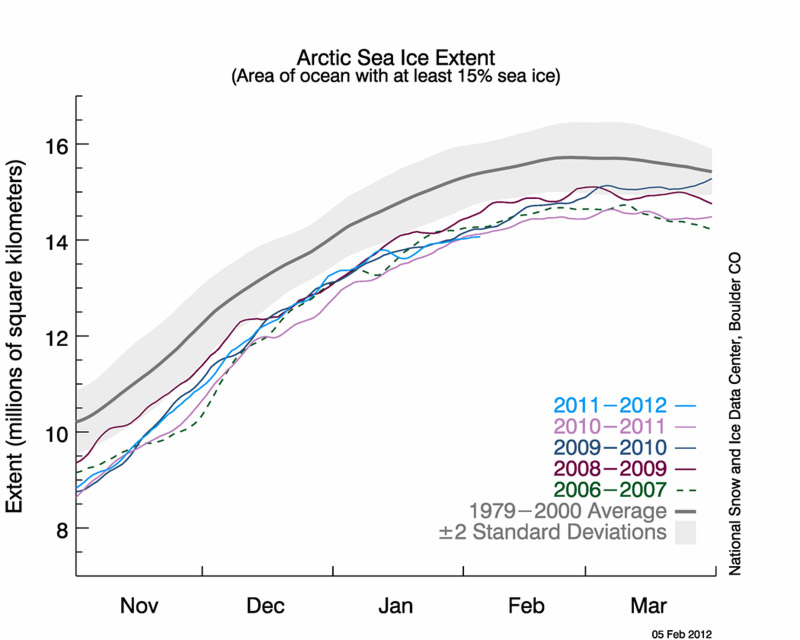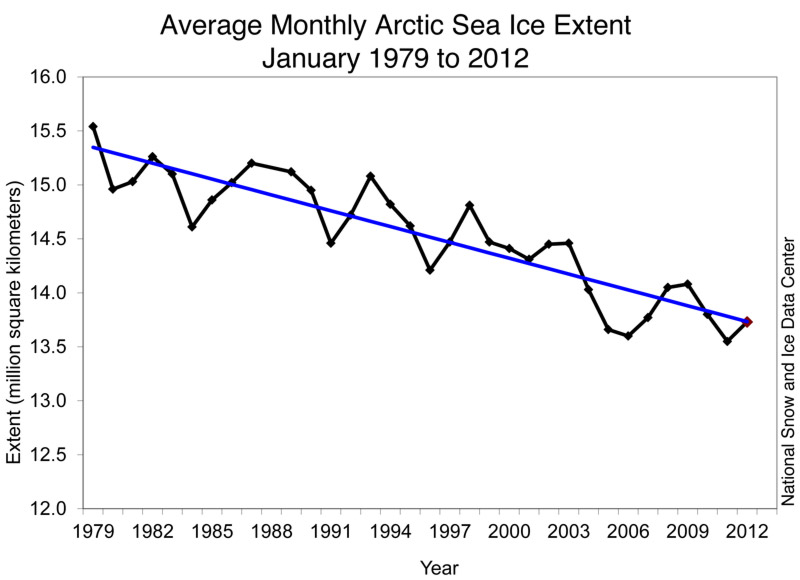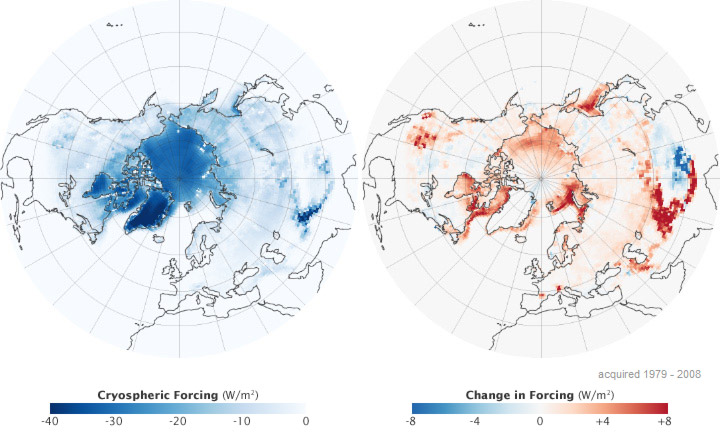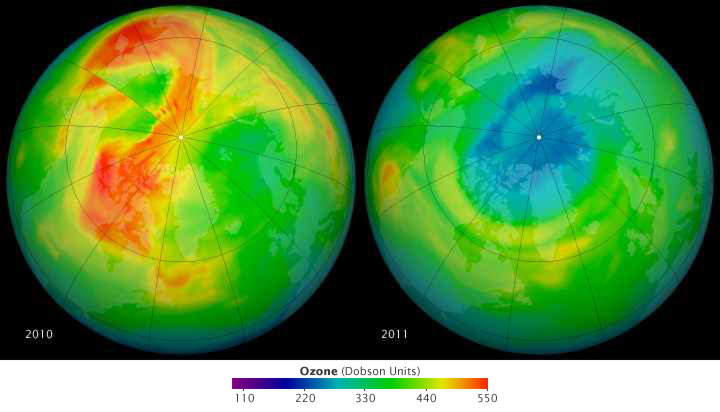Arctic Report Card: 2011 Update
The 2011 Arctic Report Card shows record-setting changes occurring throughout the Arctic environmental system. Given the projection of continued global warming, it is very likely that major Arctic changes will continue in years to come with increasing climate, biological and social impacts,” states the National Oceanographic and Atmospheric Administration (NOAA). The Arctic Report Card (www.arctic.noaa.gov/reportcard), which has been updated annually since 2006, considers a wide range of environmental observations throughout the Arctic. “A major conclusion of the 2011 Report is that there are now a sufficient number of years of data to indicate a shift in the Arctic Ocean system since 2006. This shift is characterized by the persistent decline in the thickness and summer extent of the sea ice cover and a warmer, fresher (less salty) upper ocean,” reports NOAA.
The Arctic Report Card, sponsored by NOAA’s Climate Program Office through the Arctic Research Program, is led by an inter-agency editorial team from NOAA’s Pacific Marine Environmental Laboratory, the U.S. Army Corps of Engineers’ Cold Regions Research and Engineering Laboratory (CRREL) and the Office of Naval Research (ONR) Arctic and Global Prediction Program. The final product, written by 121 researchers in 14 countries reporting published and ongoing scientific research and observations, was divided into five sections: Atmosphere, Sea Ice and Ocean, Marine Ecosystems, Terrestrial Ecosystems, and Hydrology and Terrestrial Cryosphere. Peer-review of the 23 essays included in the Report was facilitated by the Arctic Monitoring and Assessment Program (AMAP).
“The Arctic Report Card, 2011 Update, was released December 2011 and draws attention to a number of issues in the Arctic. It focuses on a variety of indicators in the physical and biological systems in the Arctic that tell us something about what’s happening in the Arctic system. These vary from sea ice cover, ocean temperature and salinity, and what’s happening in the atmosphere with temperature and clouds to marine mammals and primary productivity. It also includes the cryosphere and hydrosphere with snow, glaciers, ice sheets, permafrost, lake and river discharge. So, it covers a broad range of key indicators of the state of the Arctic environmental system,” explains Martin Jeffries, Ph.D., co-editor of the Arctic Report Card.
The overarching message is “there’s now a significant body of data to indicate that in the last five years the Arctic Ocean system appears to have undergone a significant shift to one of thinner sea ice with much reduced ice extent in the summer time, coupled with the development of a warmer, fresher ocean that’s subject to acidification. Added to that are changes in the physical system, which are leading to significant changes in the marine ecosystem. These include increased primary productivity at the bottom of the food chain (phytoplankton are the base of the ocean food web) while at the other end of the food chain loss of sea ice means loss of habitat for charismatic megafauna, such as walrus and polar bears,” explains Jeffries. In other words, loss of sea ice and changes to the ocean itself are having a cascading effect throughout the system, thus impacting marine organisms from the very smallest to the very largest.

Credit: National Snow and Ice Data Center|The graph above shows daily Arctic sea ice extent as of February 5, 2012, along with the ice extents for the previous four years.

Credit: National Snow and Ice Data Center|Monthly January ice extent for 1979 to 2012
shows a decline of 3.2% per decade.
Significant focus continues to be on the dramatic loss of sea ice. According to the Arctic Report Card, “2011’s end-of-summer ice extent was the second smallest of the 32-year satellite record. The past five years have had the five smallest September ice extents, showing that Arctic sea ice has not recovered from the large decrease observed in 2007.” These changes are leading to continued speculation about likely increases in maritime transportation; trans-Arctic shipping; tourism, including cruise ships; increased access to natural resources and the need for search and rescue. Concomitant with those are concerns regarding risks of pollution and oil spills, and, thus, the need for preparedness and response. With respect to predictions of future sea ice cover, computer models range from a relatively conservative timeframe of 40 to 50 years before the Arctic Ocean is largely ice-free by end of summer to a less conservative timeframe of only five to 10 years.
Differences in modeling, according to Jeffries, “are largely due to the fact that models differ amongst themselves in terms of their treatment of the physics of the interactions and feedbacks and processes occurring in this very complex, coupled atmosphere ice-ocean system. In addition, we’re quite certain that we don’t fully understand all these processes, interactions and feedbacks. There may also be things happening that we don’t even know exist, which indicates the need for further research and long-term observation of what’s happening in the different components of the Arctic environmental system.”
Although change in ice cover is driving significant attention to the Arctic as a whole, it is not just change in ice cover that is occurring. Jeffries points out that “when we look at changes in the environment, we need to always remember the system. Changes in one part of the system lead to changes elsewhere in the system, and those changes can be quite dramatic as well and equally important in terms of the impact on people. Changes in ice and ocean also seem to be leading to significant marine ecosystem changes as well as to changes on land, such as increased greenness of tundra vegetation, suggesting greater vegetation or ecosystem productivity. In these areas there’s also evidence that both air temperatures at the surface of the land and ground temperatures in the permafrost (permanently frozen ground) are increasing. This means permafrost is warming and, in some places, thawing, which has significant consequences, not the least of which is for the built infrastructure – roads, airports, communities, buildings and so on.”
In addition to vegetation and permafrost changes, glaciers and ice caps are losing ice mass due to melting. When melt water runs into the ocean, it contributes to rising global sea levels. With more than one-half the world’s population living and working within 120 miles of a coast (two-thirds within 240 miles), according to The Coastal Population Explosion, rising sea levels have very broad consequences. And, as Jeffries explains, “those consequences are beginning in the Arctic. For many people, the Arctic may be a cold, dark, faraway place, but it’s affecting the rest of the planet.
“In recent years, we’ve seen a significant increase in the area of melting at the surface of the Greenland Ice Sheet, the largest glacial ice body in the northern hemisphere. A large proportion of this melting appears to be related to changing air temperatures, a warming of the atmosphere particularly over West Greenland. This is not only leading to warming, but we’re also seeing reduced precipitation, particularly in the summer on the Greenland Ice Sheet. This warming and lower summer snowfall may be contributing to increased melting and, thus, runoff contributing to rising sea level.”

NASA image by Rob Simmon, made with data provided by Mark Flanner, University of Michigan.| How melting snow and ice affect weather.
Arctic changes are also affecting marine mammals, such as walruses, whales and polar bears. The Arctic Report Card says seven of 19 polar bear sub-populations appear to be declining in number with two linked to reductions in sea ice. “As sea ice retreats, that’s a loss of polar bear habitat,” explains Jeffries, “because they are what’s known as ‘ice-associated mammals.’ The sea ice is their habitat; they depend upon it to survive because seals, one of their main food sources, are also ice-associated mammals. Therefore, if seals lose habitat then polar bears lose food and habitat. Since different polar bear sub-populations live in different areas of the Arctic, and ice loss is not uniformly distributed around the Arctic, the impact on polar bears is likely to be non-uniform. There’s concern that the impact on polar bears will be greater in some areas than in others. And, in some areas this may lead to extirpation, which is local extinction of a population.”
Some polar bear sub-populations will likely continue in areas where the ice survives longer. The areas where sea ice is the oldest and thickest – along the Arctic edge of the Canadian Archipelago and north of Greenland – are where experts expect polar bears to survive the longest. Jeffries says these areas are “talked of as ‘refugia’ (refuge for an isolated species population that was once more widespread) for polar bears. Maybe those polar bear populations will survive. But, maybe polar bear populations will adapt in those areas where ice cover is disappearing more quickly. This may include moving onto land and becoming more of a terrestrial bear than a marine bear. There’s some evidence that bears are moving onto and spending longer periods of time on land in the summer; maybe their diet is changing as well. One thing is certain; we can expect changes in sea ice to affect polar bears in some way.”
The Arctic Report Card indicates that another significant impact on the marine ecosystem linked to the persistent reduction of sea ice is ocean acidification. Jeffries says this is due to increasing carbon dioxide concentrations in the atmosphere. He explains: “The ocean is potentially a great sink for absorbing carbon dioxide. And, we know the solubility of carbon dioxide is greater in cold water than in warm water. Since Arctic Ocean waters are colder than lower latitude ocean waters, we expect more carbon dioxide to go into solution and lower the pH; i.e., the waters become more acidic. Couple that with the fact that as sea ice retreats in the summertime, more of those cooler waters in the Arctic Ocean are exposed to the atmosphere. One of the main concerns of ocean acidification is that calcifying marine microorganisms are more vulnerable to acidic ocean water, as it is able to dissolve calcium carbonate (that’s why they’re called calcifying organisms) more readily.”
Jeffries says changes in ice cover in the ocean are also leading to changes in the atmosphere, including changes in atmospheric circulation. This is causing, according to the Arctic Report Card, “the repeated occurrence of a wind pattern that pushes cold Arctic air into lower latitudes and pulls warmer air into the Arctic. During the last two winters, this exchange resulted in severe cold weather in eastern North America, northern Europe and eastern Asia. It also resulted in higher than normal air temperatures in the Arctic. . . . Another potential indicator of recent atmospheric changes was the record low ozone concentrations in March 2011, thus leading to elevated UV levels throughout the Arctic and sub-Arctic.”

NASA image by Rob Simmon, with data courtesy of Ozone Hole Watch.|The ozone layer.
“We need to look at the Arctic itself as a system of interacting components affecting each other through a variety of feedbacks. Also, we should never forget that the Arctic is part of the global environmental system, which is both affected by and affects the rest of the planet. It’s very complex and extremely relevant for everyone because it’s very much connected to the rest of the planet. In some respects, it’s fair to say that the Arctic is like the canary in the coal mine,” comments Jeffries.
Arctic scientists are, obviously, much closer to what is happening in the Arctic because many have actually worked there. As a result, according to Jeffries, these changes have “a very personal effect on us. I’ve been doing Arctic research since I first went to the sub-Arctic and crossed the Arctic Circle in 1980. I’ve personally witnessed many environmental changes during my career as an Arctic researcher. For instance, I did my Ph.D. research in the early-to-mid 1980s on ice shelves that occur along the north coast of Ellesmere Island in the Canadian high Arctic. Those ice shelves have been much diminished since. I’ve watched them disintegrate until they are now a fraction of the extent they were in the early 1980s when I was actually working and traveling on them. It’s quite striking, and it really drives home the rate of change when the body or bodies of ice that you were studying for your Ph.D. that kicked off your career have practically disappeared.
“I was reminded of this a few months ago when a colleague of mine, Jim Overland (NOAA Pacific Marine Environmental Laboratory and a co-editor of the Report Card), was describing how in September 2009 he was aboard a U.S. Coast Guard C-130 Arctic Domain Awareness flight flying north of Alaska into the Arctic basin. The plane flew north and continued flying north and there was no sea ice to be seen. Jim described it as being very emotional for him because the plane kept flying further and further north, and there was no ice in an area where 30 years ago he was on the ice studying it and doing research. Again, this is something that drove home to him the scale of the changes that we’re seeing.
“I think the general public is concerned about these changes because they’re interested in the Arctic. I suppose they relate most to what’s happening to the ecosystem, particularly the large mammals, such as polar bear, walrus and whales. They’re not called ‘charismatic megafauna’ for nothing. . . But, it’s a challenge to communicate the importance of the Arctic to a global audience, to help them understand that changes in the Arctic don’t stay in the Arctic. It’s a bit like Las Vegas, except what happens in the Arctic doesn’t stay in the Arctic. It has global consequences. The Arctic and changes in the Arctic are in the news frequently, but people read about it, quickly forget and go about their daily lives. Changes in the Arctic are important to everyone, not just the people who live in the Arctic or the animals that are unique to the Arctic.
“It’s important for people everywhere to understand that the Arctic environmental system continues to change rapidly. These changes are cascading throughout the system affecting marine and terrestrial ecosystems, and are not limited to the Arctic. They have global consequences. Therefore, to understand and predict these changes and their impact both in the Arctic and globally, there’s no question much research needs to be done. I would expect that we’ll continue to see a significant loss of sea ice in the summer and that we’ll probably continue to see a trend to even less sea ice and more open water. As to the question of when we might see a largely sea ice-free Arctic Ocean at the end of one summer in the future. Well, if it happens during my lifetime, I wouldn’t be at all surprised, and I’m 53 years old.”




























